|
|
|
Sort Order |
|
|
|
Items / Page
|
|
|
|
|
|
|
| Srl | Item |
| 1 |
ID:
191795
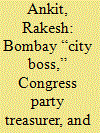

|
|
|
|
|
| Summary/Abstract |
S.K. Patil, quintessential Congressman of Bombay city and cabinet minister in three central governments from 1957 to 1963 and 1964 to 1967, was the kind of figure in Indian politics, who personified Rajni Kothari’s Congress “system” of clients-patrons and chains-links. A Patelite, Patil was a thorn in Nehru’s side. A leader of the business community, he identified with a network politics involving capital. He was an indifferent administrator, but an influential party apparatchik and his career peaked in 1964–1967, when he was a part of the all-important Congress “syndicate.” Afterward, however, he struggled for relevance in the turbulent decade of the 1970s. In this research article based on Patil’s personal papers, I offer these fragments from his political life as interesting prisms through which to view (a) aspects of intra-party and inter-ministerial conflictual culture, (b) issues concerning the top-down character of governance with implications for public policy and (c) the complex opposition to it, both inside and outside, thereby repaying this visit to an individual’s trajectory in contemporary history with parallels for current politics.
|
|
|
|
|
|
|
|
|
|
|
|
|
|
|
|
| 2 |
ID:
177791


|
|
|
|
|
| Summary/Abstract |
The presence of a curious Iranian in Bombay in 1801–1804 resulted in an unpublished extensive diary, a record containing much valuable data about urban development and business relations in this harbour city. The author’s daily commentary and precise notes, compiled over the first 3 years of the nineteenth century, constitutes an unusual archive from colonial times, providing information about Bombay and its Parsis, as well as the role of Persians in the economy and politics of India under the East India Company (EIC).
|
|
|
|
|
|
|
|
|
|
|
|
|
|
|
|
| 3 |
ID:
179908
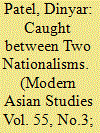

|
|
|
|
|
| Summary/Abstract |
In 1922, a group of wealthy Parsis in Bombay founded an organization that they dubbed the Iran League. Originally designed to assist their fellow Zoroastrians in Iran, who had suffered from centuries of oppression, the League quickly expanded its objectives to include the promotion of broader Indo-Iranian cultural and economic relations. It became a major player in the flow of ideas, literature, business, and tourist traffic between the two countries. Parsi fervour for Iran stemmed from the brand of Iranian nationalism promoted by Reza Shah, which celebrated the country's Zoroastrian past. In response, the League's leaders argued that the Parsis of India could play a special role in the ‘regeneration’ of Iran under the shah's supposedly benign rule. By the 1930s, however, Parsis’ embrace of Iranian nationalism became a clear reflection of their deep concerns about Indian nationalist politics: they cast Iran as an idealized alternative to contemporary India, where the Indian National Congress had supposedly taken an ominously ‘anti-Parsi’ turn. The Iran League, therefore, was caught between two nationalisms. Worry about India's future even prompted some Parsis to argue that their community should ‘return’ to their ancestral homeland of Iran. The story of the Iran League thus demonstrates the complex position of minorities vis-à-vis the brands of nationalism in development during the interwar years. The Parsis, a wealthy but microscopic minority, responded to political anxieties at home by romanticizing a foreign country and taking part in a wholly foreign nationalist project.
|
|
|
|
|
|
|
|
|
|
|
|
|
|
|
|
| 4 |
ID:
123069
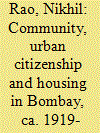

|
|
|
|
|
| Publication |
2013.
|
| Summary/Abstract |
From the late 1910s onward, co-operative housing societies in cities like Bombay offered affordable housing by using the agency of community to protect against the vicissitudes of the market. At the same time, ideas of urban citizenship premised on the liberal individual received greater attention with a broadened franchise and became increasingly linked to social rights such as affordable housing. While the community and the individual are seen as opposed to one another in the discourse of citizenship, this paper suggests that they mutually informed and constituted one another between 1919 and 1980 in ways that have enduring significance for understandings of urban citizenship.
|
|
|
|
|
|
|
|
|
|
|
|
|
|
|
|
| 5 |
ID:
142833
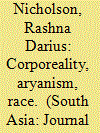

|
|
|
|
|
| Summary/Abstract |
Recent scholarship has problematised the ‘impact-response’ theory that ideas such as Aryanism, eugenics and militarism were merely imported from a European context into a South Asian one. This paper delineates a longer trajectory of the relationship between corporeal language and communal identity through a focus on the Parsi community of western India. As early as 1853, reformist Parsis enacted modes of ancient Kayānī virility in the gymnasium and theatre to redefine notions of communal identity that drew simultaneously from Enlightenment precepts and a mythic Aryan heritage discovered by Orientalists. Subsequently, the confluence of a loss of numerical, financial and political strength, and the popularisation of the ideas of Darwin and Mendel, prompted a shift in ethnic and semantic thinking, whereby the language of corporeality was co-opted by the orthodox faction to justify the bifurcation of religion and race. Consequently, Parsis, in the midst of a rising Hindu nationalist movement, called not only for the revival of Persian epic theatre, a Parsi militia, the exclusion of ‘half-castes’ from the community and the castration of ‘mentally defective’ community members, but also for a renewal of ties to Iran and a separate state of Parsistan.
|
|
|
|
|
|
|
|
|
|
|
|
|
|
|
|
| 6 |
ID:
143205
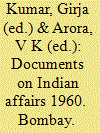

|
|
|
|
|
| Publication |
Bombay, Asia Publishing House, 1965.
|
| Description |
xxii, 636p.hbk
|
|
|
|
|
|
|
|
|
|
|
|
Copies: C:1/I:0,R:1,Q:0
Circulation
| Accession# | Call# | Current Location | Status | Policy | Location |
| 000390 | 025.954042/KUM 000390 | Main | On Shelf | Reference books | |
|
|
|
|
| 7 |
ID:
114658
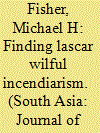

|
|
|
|
|
| Publication |
2012.
|
| Summary/Abstract |
From the 1790s to the 1850s, three dozen major merchant ships burned in India's important ports. Panic-stricken British shipowners, merchants and East India Company officials apprehended disruption of their intercontinental trade, so vital to the burgeoning British Empire. In all these cases, they accused Indian seamen (lascars) of selfish ship-burning. As a context, the lascars had, for centuries prior to European arrival in the Indian Ocean, worked collectively under their own petty officers. They and Indian recruiters in each port had long resisted colonial efforts to appropriate their maritime labour system. Britons used this half-century of alleged arson to finally impose British controls over lascar recruitment ashore and conditions of service aboard ships.
|
|
|
|
|
|
|
|
|
|
|
|
|
|
|
|
| 8 |
ID:
190731
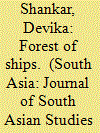

|
|
|
|
|
| Summary/Abstract |
This paper examines how the annexation of Malabar by the English East India Company in the last decade of the eighteenth century allowed the colonial administration to experiment with novel forms of state control in the region’s forests. At the same time, through a focus on the connections forged between Malabar’s forests and Bombay’s dockyards, this paper will use archival sources to examine the crucial role played by the timber monopoly introduced in 1806 in dislodging Malabar and its ports from their central position in the Indian Ocean economy and facilitating their incorporation into the margins of the emerging colonial economy.
|
|
|
|
|
|
|
|
|
|
|
|
|
|
|
|
| 9 |
ID:
115293
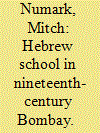

|
|
|
|
|
| Publication |
2012.
|
| Summary/Abstract |
This paper is a study of cultural interaction and diffusion in colonial Bombay. Focusing on Hebrew language instruction, it examines the encounter between India's little-known Bene Israel Jewish community and Protestant missionaries. Whilst eighteenth and nineteenth-century Cochin Jews were responsible for teaching the Bene Israel Jewish liturgy and forms of worship, the Bene Israel acquired Hebrew and Biblical knowledge primarily from nineteenth-century Protestant missionaries. At the beginning of the nineteenth century, the Bene Israel community was a Konkan jati with limited knowledge of Judaism. However, by the end of the century the community had become an Indian-Jewish community roughly analogous to other Jewish communities. This paper explores how this transformation occurred, detailing the content, motivation, and means by which British and American missionaries and, to a lesser extent, Cochin Jews instructed the Bene Israel in Jewish knowledge. Through a critical examination of neglected English and Marathi sources, it reconstructs the Bene Israel perspective in these encounters and their attitude towards the Christian missionaries who laboured amongst them. It demonstrates that the Bene Israel were active participants and selective consumers in their interaction with the missionaries, taking what they wanted most from the encounter: knowledge of the Old Testament and the Hebrew language. Ultimately, the instruction the Bene Israel received from Protestant missionaries did not convert them to Christianity but strengthened and transformed their Judaism.
|
|
|
|
|
|
|
|
|
|
|
|
|
|
|
|
| 10 |
ID:
157124
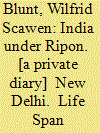

|
|
|
|
|
| Publication |
New Delhi, Life Span Publishers and Distributors, 2015.
|
| Description |
v, 284p.hbk
|
| Standard Number |
9789381709832
|
|
|
|
|
|
|
|
|
|
|
|
Copies: C:1/I:0,R:0,Q:0
Circulation
| Accession# | Call# | Current Location | Status | Policy | Location |
| 059286 | 954.0353/BLU 059286 | Main | On Shelf | General | |
|
|
|
|
| 11 |
ID:
085018
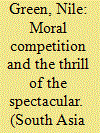

|
|
|
|
|
| Publication |
2008.
|
| Summary/Abstract |
At 10:15 on the night of 31 May 1903, the D-block of the recently completed Sita Ram Building in Bombay suddenly came down with a crash. Most of the building was unoccupied, but on the ground floor was a saloon bar, which over the past months had done a brisk trade with British soldiers and sailors. The customers of this bar comprised most of the dead and injured when the building collapsed.
Since the bar stood across the road from the tomb of a Muslim saint, rumours spread that the disaster was the direct result of the insult to the holy man and implicitly of the transgression of Muslim space by the combined efforts of the Hindu bar-owner and his bibulous patrons. This short essay explores the moral tensions that found expression with the collapse of the Sita Ram Building through a comparison of its reportage in an English-language newspaper and an Urdu hagiography of the offended saint. At the same time, it draws attention to the neglected importance of colonial Bombay as a prime location of the early Muslim experience of globalising modernity
|
|
|
|
|
|
|
|
|
|
|
|
|
|
|
|
| 12 |
ID:
120857
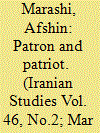

|
|
|
|
|
| Publication |
2013.
|
| Summary/Abstract |
This article examines the life and work of Dinshah Irani, a prominent Parsi scholar, lawyer and philanthropist who was a key intellectual intermediary between the Parsi community of Bombay and the intellectual community of Iranian nationalists during the 1920s and 1930s. The article details the role played by Irani in patronizing the publication of Zoroastrian-themed printed works in Bombay that were intended for export to the reading market in Iran. By focusing on the life and work of Dinshah Irani, the article details the important role the Parsi community of Bombay played in the revival of Iranian antiquity during the early twentieth century. The article also highlights the transnational cultural and intellectual history of Iranian nationalism during the Reza Shah period.
|
|
|
|
|
|
|
|
|
|
|
|
|
|
|
|
| 13 |
ID:
184785
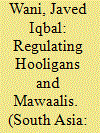

|
|
|
|
|
| Summary/Abstract |
In 1938, a communal conflict took place in the city of Bombay. This confrontation between Hindus and Muslims flared into large-scale violence. During the riots, the home minister of the provincial government invoked a combination of laws such as Section 144 of the Code of Criminal Procedure and instituted curfews to control the situation. As a result, hundreds of inhabitants of the city were arrested. The purpose of this article is threefold. Firstly, it will highlight how communal conflict in the late colonial period would often begin over trivial issues but could easily expand into large-scale riots influenced by metapolitical concerns. Secondly, moments of ‘disorder’ facilitated the administrative urge to institute extraordinary laws like Section 144 and curfews. And thirdly, the invocation of extraordinary laws was justified in reference to various problem categories like mawaalis and hooligans in this case. Overall, the article will show that the provincial government led by Indians continued the colonial art of governance by resorting to repression as a significant tool to deal with political unrest.
|
|
|
|
|
|
|
|
|
|
|
|
|
|
|
|
| 14 |
ID:
185592
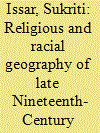

|
|
|
|
|
| Summary/Abstract |
The spatial separation of European colonialists and the local population was long seen as the defining feature of colonial cities. In recent years, the literature has moved toward a more ambivalent and contingent view of this spatial separation. This paper attempts to look beyond imagining the colonial city in terms of stark dualities or revisionist ambivalences, addressing both religious and racial separation. The paper analyses the street-level religious and racial geography of late nineteenth-century Bombay, using data from the 1881 Census. Results suggest moderate to high levels of racial and religious segregation in nineteenth-century Bombay at the street level, varying across groups, coupled with the existence of enclaves, and expressions of preference for segregation in diverse domains. The paper concludes that religion and race were meaningful social categories inscribed in urban space.
|
|
|
|
|
|
|
|
|
|
|
|
|
|
|
|
| 15 |
ID:
126170
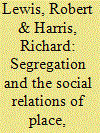

|
|
|
|
|
| Publication |
2013.
|
| Summary/Abstract |
For many, a defining feature of the colonial Indian city is the high rate of segregation of its European and Indians residents. Building on recent work that explores the messy realities of social and spatial relations, this paper argues that the social geographies of the colonial city were built on the social relations of place-the network of social relations that are bound up with a particular material setting. The result was that social spaces were centred on overlapping geographic patterns, intense negotiations over space, and heterogeneous lived-in spaces. In this paper, these points are examined through the case of Bombay's Modern Town at the turn of the twentieth century. Modern Town was supposedly the home of the city's European population and it stood in sharp contrast to the city's Native Town. However, Modern Town did not conform to the spatial topographies described by most writers. While formal residential segregation existed, social and economic articulation and interaction ensured that the district's social spaces were meshed in differentiated and complex ways.
|
|
|
|
|
|
|
|
|
|
|
|
|
|
|
|
| 16 |
ID:
115284
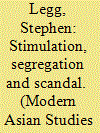

|
|
|
|
|
| Publication |
2012.
|
| Summary/Abstract |
This paper explores the regulation of prostitution in colonial India between the abolition of the Indian Contagious Diseases Act in 1888 and the passing of the first Suppression of Immoral Traffic Act in 1923. It challenges the commonly held assumption that prostitutes naturally segregated themselves in Indian cities, and shows that this was a policy advocated by the Government of India. The object was to prevent the military visiting these segregated areas, in the absence of effective Cantonment Regulations for registering, inspecting, and treating prostitutes. The central government stimulated provincial segregation through expressing its desires via demi-official memoranda and confidential correspondence, to which Rangoon and Bombay responded most willingly. The second half of the paper explores the conditions, in both India and Ceylon, that made these segregated areas into scandalous sites in the early twentieth century. It situates the brothel amongst changing beliefs that they: increased rather than decreased incidents of homosexuality; stimulated trafficking in women and children; and encouraged the spread of scandalous white prostitutes 'up-country', beyond their tolerated location in coastal cosmopolitan ports. Taken alongside demands that the state support social reform in the early twentieth century, segregation provided the tipping point for the shift towards suppression from 1917 onwards. It also illustrates the scalar shifts in which central-local relations, and relations between provinces, in government were being negotiated in advance of the dyarchy system formalized in 1919.
|
|
|
|
|
|
|
|
|
|
|
|
|
|
|
|
| 17 |
ID:
015518
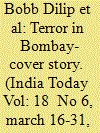

|
|
|
|
|
| Publication |
march 16-31, 1993.
|
| Description |
42-53
|
|
|
|
|
|
|
|
|
|
|
|
|
|
|
|
| 18 |
ID:
097727
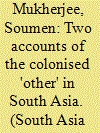

|
|
|
|
|
| Publication |
2010.
|
| Summary/Abstract |
Taking examples from South Asia, this article shows how British colonial knowledge about the non-European 'other' hinged substantially on the participation of sections of that other, especially in the context of liminal groups, for whom no ready standardised formula of identification was available. Development of a colonial episteme often involved active intervention from the colonised body, thereby dispelling any strict notion of coloniser-colonised alterity and mere top-down governance. This process of identity construction took place in several arenas and also involved negotiations in courts of law, where rival sections of the amorphous colonised body fought for competing ideals of selfhood. Complementing this legal construction were ethnographic formulations, internally diverse, and often relating to broader politico-intellectual concerns and debates of the Empire, at different planes in different ways. The article explicates their theoretical bases and practical modalities.
|
|
|
|
|
|
|
|
|
|
|
|
|
|
|
|
|
|
|
|
|